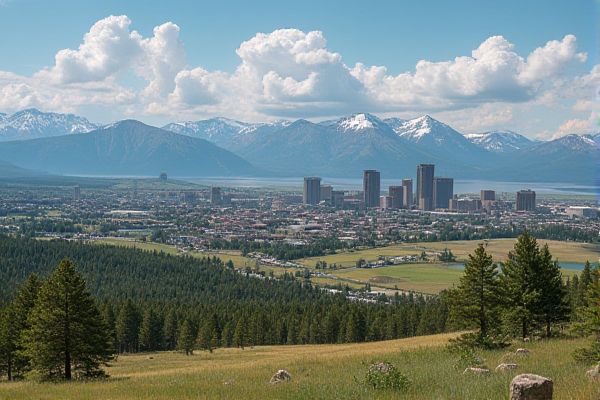
Moving to Montana checklist: Weather variations by season and region. Cost of living differences. Housing availability and market trends. Employment opportunities and major industries. State and local taxes. Outdoor recreational activities. Public transportation options. Healthcare facilities and providers. Educational institutions and school districts. Community culture and lifestyle.
Weather variations by season and region.
Montana experiences four distinct seasons with significant variations. Summers are warm and dry, with temperatures ranging from the 70s to 90s Fahrenheit, while winters are cold and snowy, especially in mountainous areas. Spring and fall are highly variable, with rapid temperature changes, and the state is divided climatically by the Continental Divide, with the west generally having milder winters and cooler summers compared to the east. For more details on the four seasons in Montana, check out the guide on Montana Traveler.
Cost of living differences.
Montana's cost of living is 1.09 times less expensive than the U.S. average, with a total monthly cost for one person of $2030, including $1238 for rent and utilities, $588 for food, and $53.5 for transportation. Housing costs vary, with a 1-bedroom apartment in the city center costing $1210 and a 3-bedroom apartment costing $2430. For a comprehensive overview of these expenses, you can explore more details on the Living Cost website, which provides insights into how these costs stack up in comparison to national averages.
Housing availability and market trends.
In Montana, the housing market is characterized by a typical home value of approximately $463,962, marking a 2.8% increase from last year, supported by a robust inventory of 7,592 homes for sale. As per predictions, the market is expected to favor buyers in the latter half of 2024, with increased housing inventory and moderate price appreciation, although some regions may see short-term declines. For more detailed insights and updates, visit the Montana Housing Market blog.
Employment opportunities and major industries.
Montana's economy is driven by major industries such as agriculture, healthcare, forestry, energy, manufacturing, and tourism, with the service industry employing about a third of the workforce. The construction and healthcare sectors are expected to be significant job creators in the coming years. For more in-depth information on the economic landscape of this region, you can visit the article on Biggest Industries In Montana.
State and local taxes.
Montana has a progressive state income tax with rates ranging from 1% to 6.75%, no statewide sales tax, and below-average property taxes. The state also offers various tax credits, including the Earned Income Tax Credit and Homeowner/Renter Credits for eligible residents, and has specific deductions and exemptions that can reduce taxable income. To better understand how these taxes might affect you, consider using the Montana Tax Calculator, which provides detailed insights based on your financial situation.
Outdoor recreational activities.
Montana offers a wide range of outdoor recreational activities, including hiking and backpacking in Glacier National Park and the Bob Marshall Wilderness. Enthusiasts can also enjoy bicycling on various trails, horseback riding, and water recreation such as fishing and sailing. For those interested in more adventurous pursuits, rock climbing is available, alongside camping options that range from backcountry spots to developed campgrounds. For more information on these activities, you can explore the offerings on VisitMT, where you'll find details about all the exciting adventures awaiting you in this stunning state.
Public transportation options.
In Montana, public transportation options include fixed-route bus services in major cities like Billings, Bozeman, and Missoula, as well as intercity bus services provided by carriers like Jefferson Lines and Express Arrow. Additionally, Amtrak's Empire Builder train connects several northern cities. Some cities offer free or low-cost public bus services, with accessible transportation options available, though these are more limited outside major towns and cities. For more detailed information, you can visit the Transportation In Montana page.
Healthcare facilities and providers.
This resource provides a comprehensive guide for finding healthcare facilities and providers in Montana, including primary care databases, specialist resources, Medicaid information, and community services such as the Montana 211 and Medical Home Portal.
Educational institutions and school districts.
The Montana University System (MUS) oversees 16 public colleges and universities, including research institutions, 4-year and 2-year colleges, and community colleges, while also partnering with seven independent tribal colleges. For elementary and secondary education, the state is divided into numerous school districts, each with its own administration and accreditation standards managed by the Board of Public Education.
Community culture and lifestyle.
Montana is known for its strong sense of community, fostered by its rural and close-knit nature, with residents often knowing their neighbors and participating in local festivals and events that celebrate the state's rich history and culture. Moving to Montana involves adjusting to a community-centric lifestyle where relationships within the community are highly valued, and participating in local events and social gatherings is crucial for building friendships and integrating into the community. Embracing the Montana lifestyle involves immersing yourself in the local community through activities such as attending local events, joining clubs or groups aligned with your interests, and supporting local businesses to foster a sense of community and connection with fellow residents.
